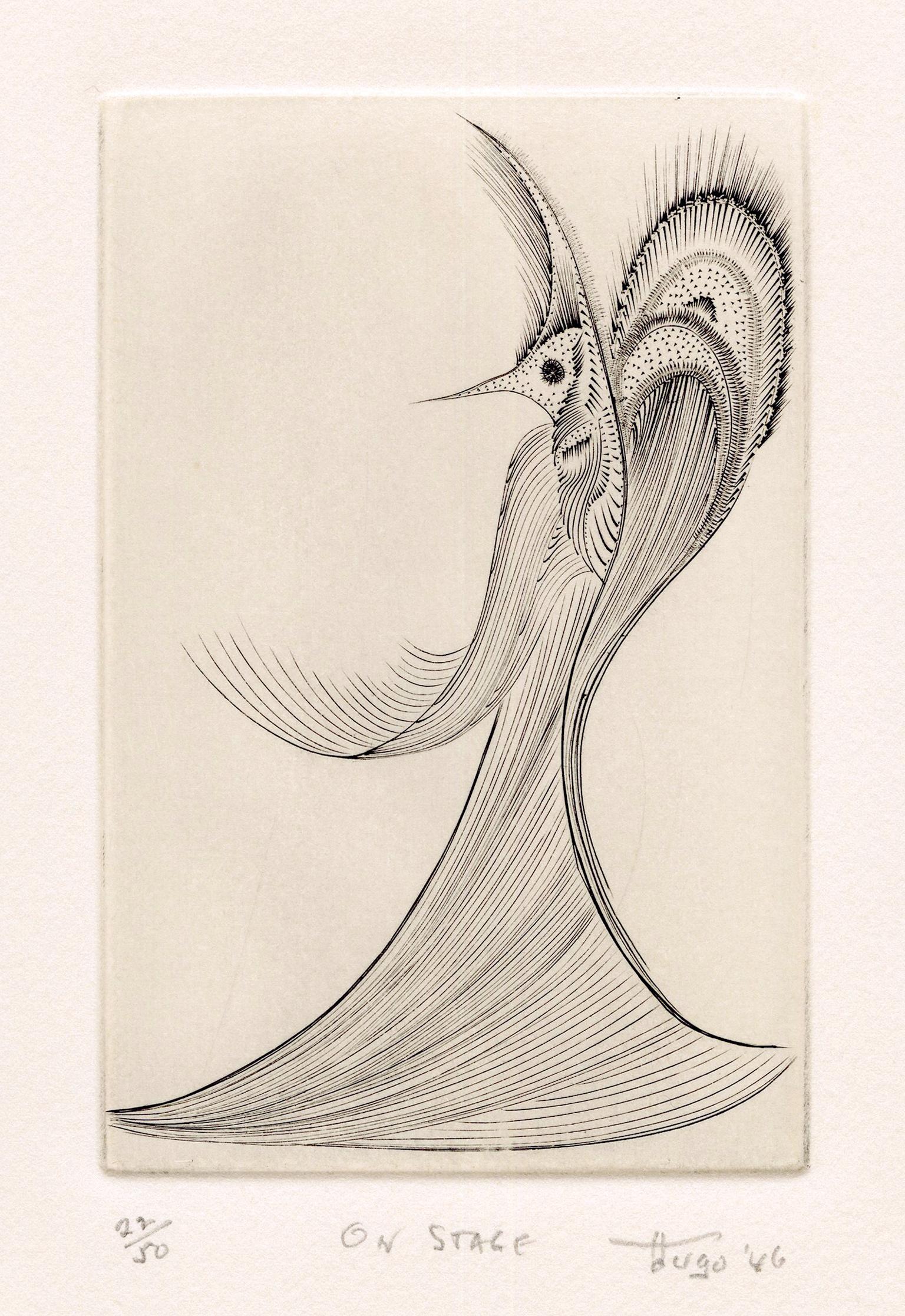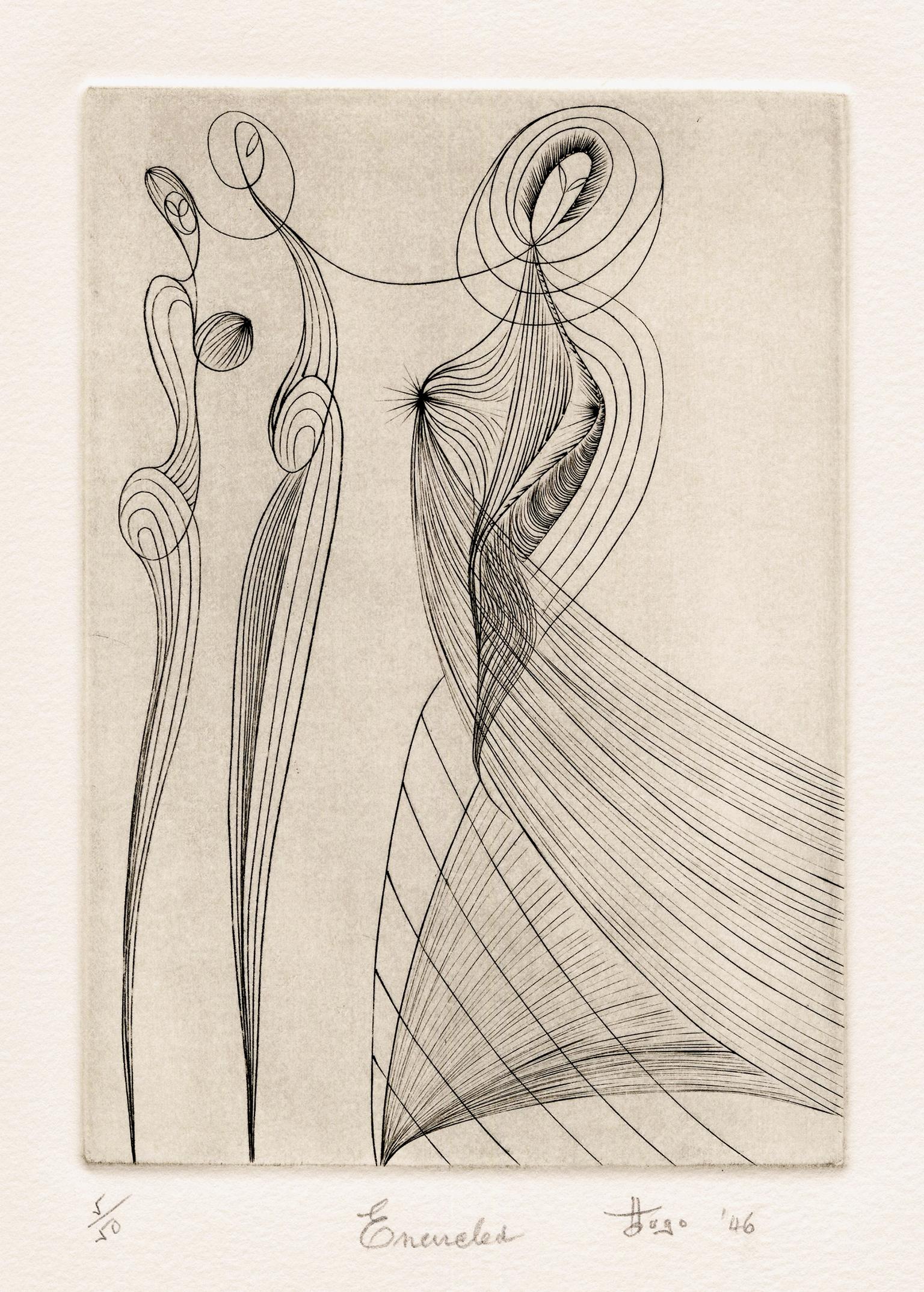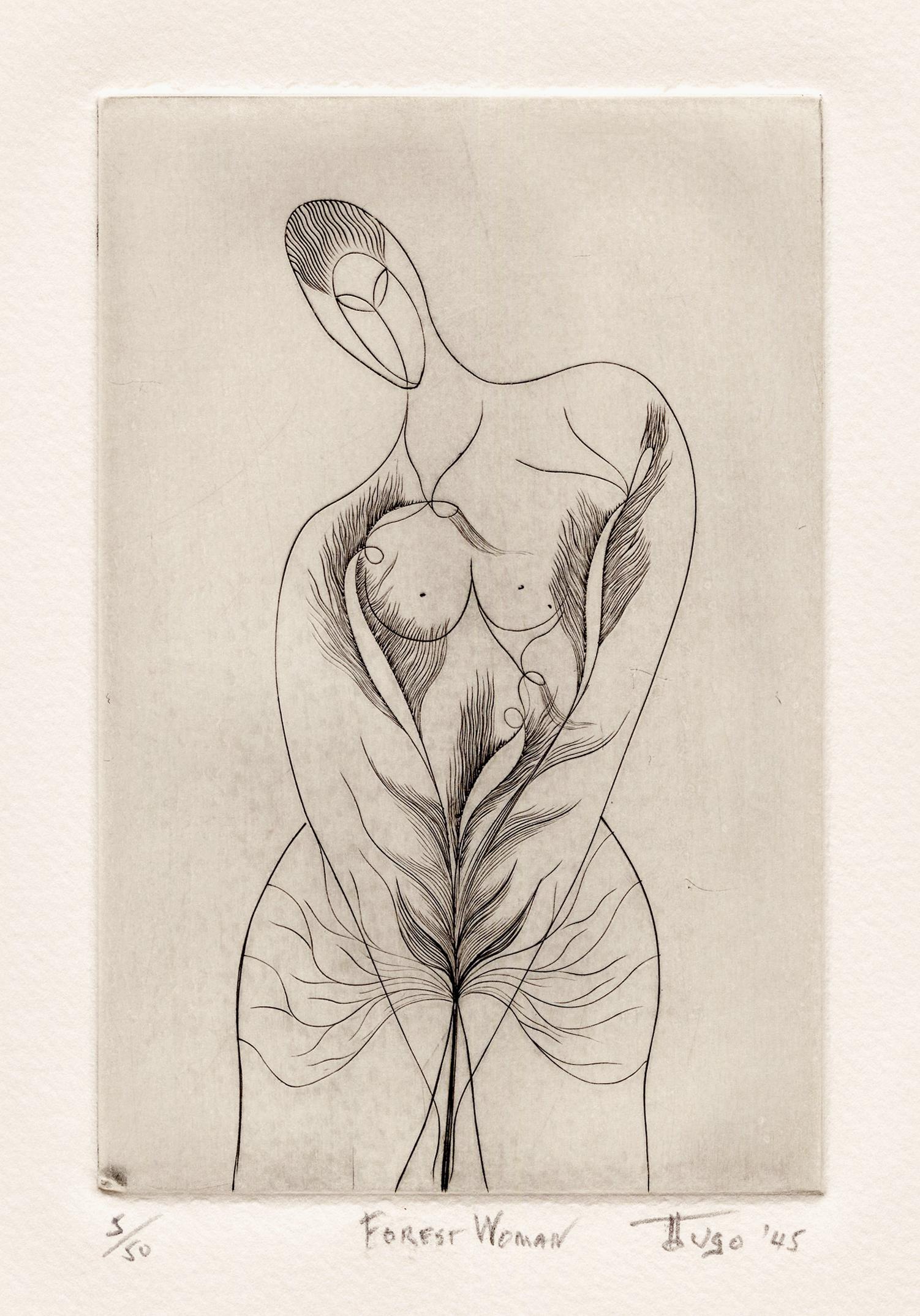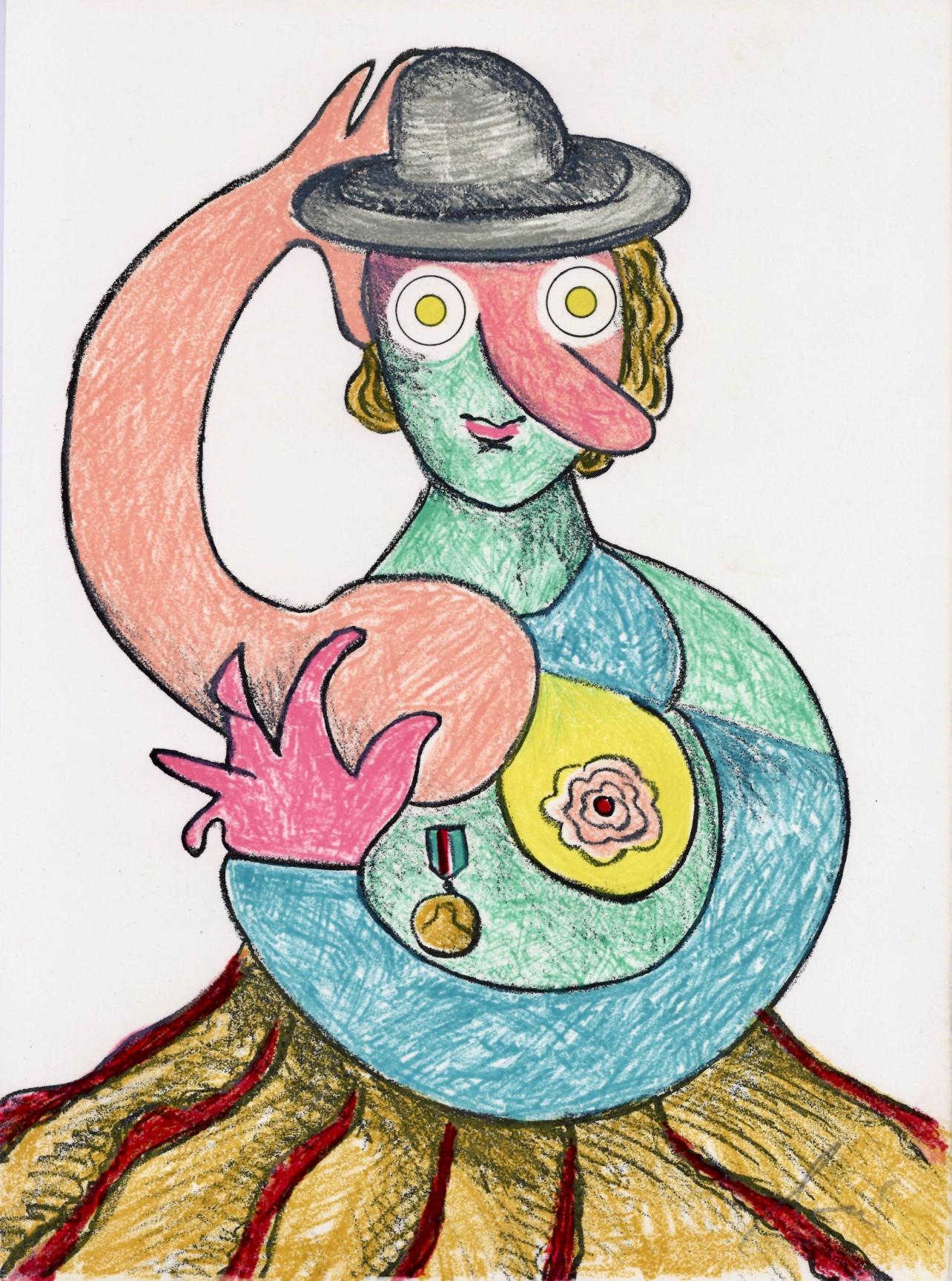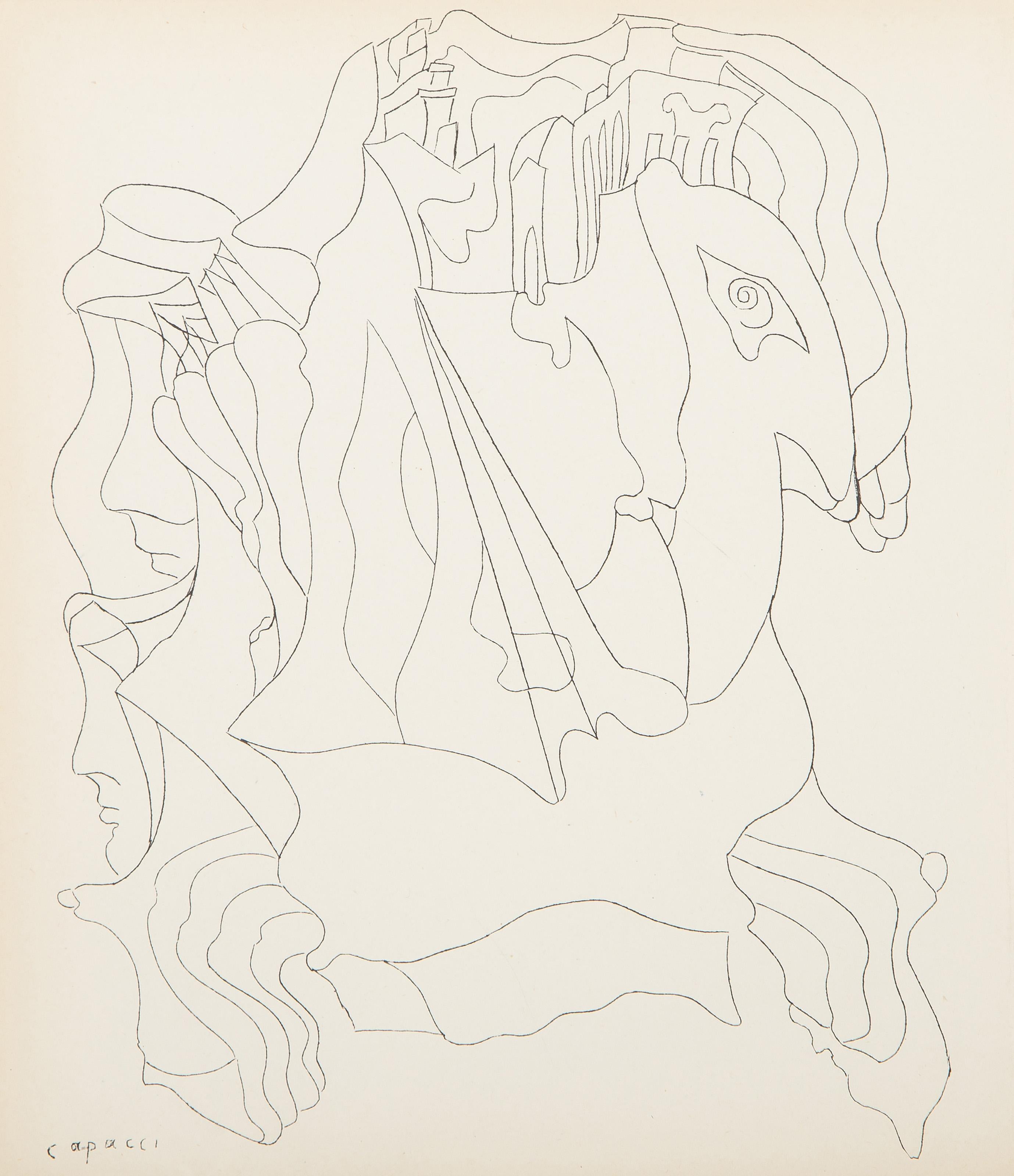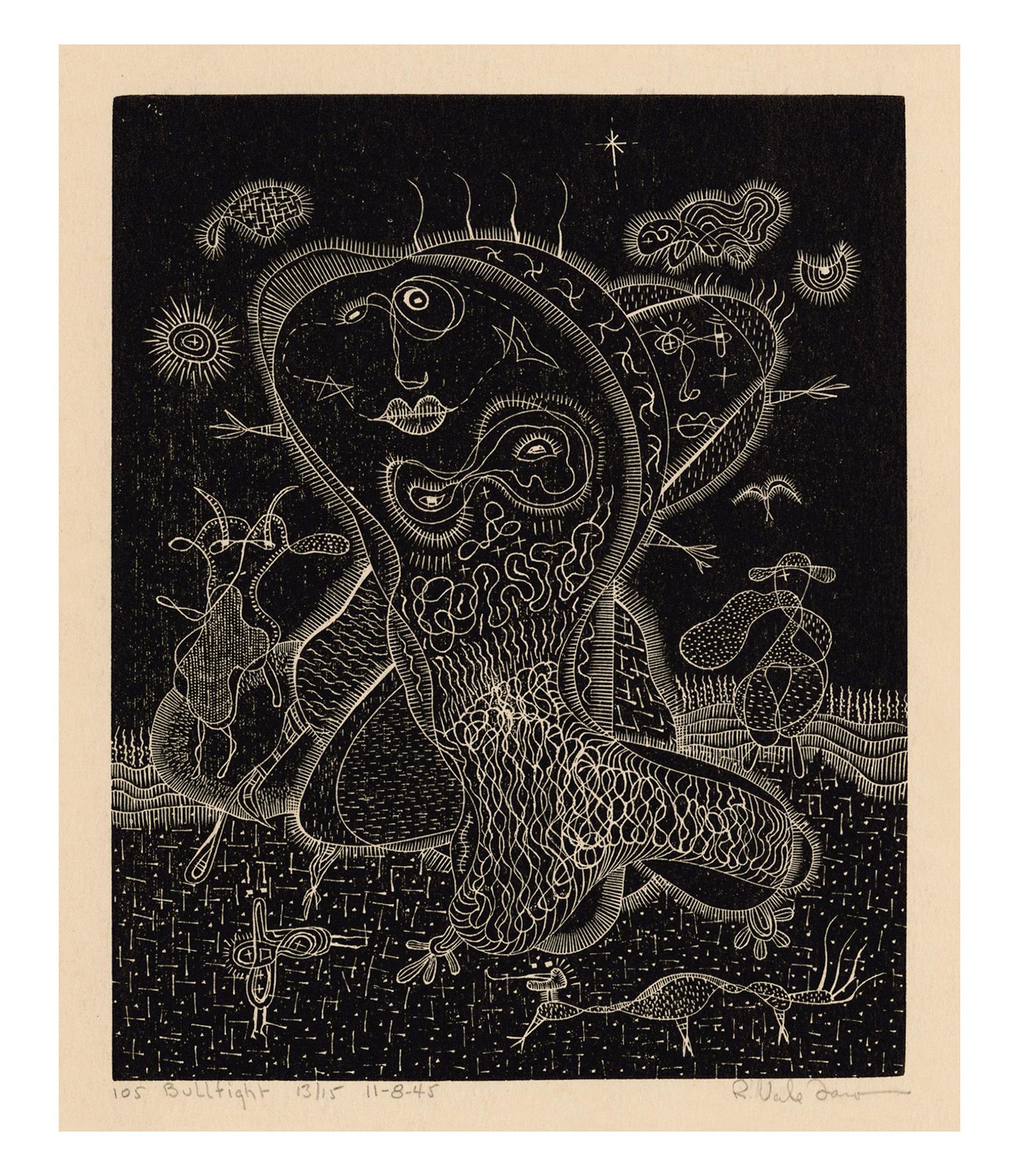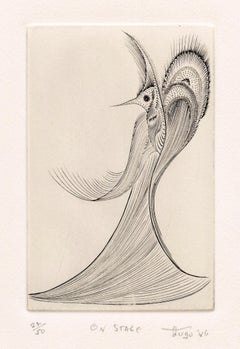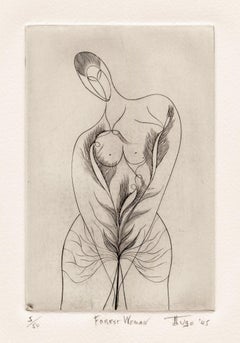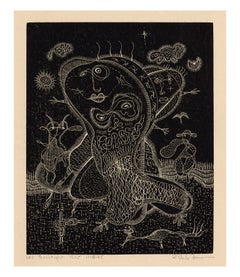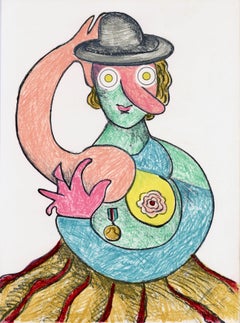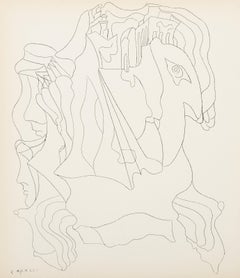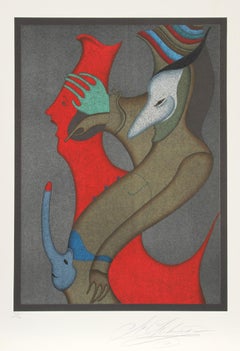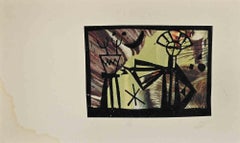Items Similar to 'Together' — Mid-Century Surrealism, Atelier 17
Want more images or videos?
Request additional images or videos from the seller
1 of 3
Ian Hugo'Together' — Mid-Century Surrealism, Atelier 171946
1946
$550
£416.73
€478.16
CA$773.94
A$850.77
CHF 447.13
MX$10,331.47
NOK 5,577.79
SEK 5,284.57
DKK 3,568.66
About the Item
Ian Hugo, 'Together', from the portfolio 'Ten Engravings'. engraving, 1946, edition 50. Signed, dated, titled, and numbered '22/50' in pencil. A fine impression, with delicate overall plate tone, on cream wove paper, the full sheet with wide margins (2 7/8 to 5 1/2 inches), in excellent condition. With the blind stamp 'madeleine-claude jobrack EDITIONS', in the bottom right margin. Matted to museum standards, unframed.
Image size 5 7/8 x 4 7/8 inches (149 x 124 mm); sheet size 15 x 11 1/8 inches (381 x 283 mm).
Collection: Indianapolis Museum of Art.
Ian Hugo originally created "Ten Engravings" in 1945 and the portfolio included a foreword by his partner and collaborator, Anais Nin. In 1978, Hugo republished the portfolio with Madeleine-Claude Jobrack, an American master printmaker who studied under Stanley William Hayter at Atelier 17, Paris, and with Johnny Friedlaender. When Jobrack returned to the States she managed the Robert Blackburn Printmaking Studio in New York before opening her own printing studio, Madeleine-Claude Jobrak Editions.
“The sign of the true artist is one who creates a complete universe, invents new plants, new animals, new figures to transfer to us a new vision of the universe in which dream and reality fuse. Ian Hugo's plants have eyes, the birds have the delicacy of dragonflies, their feathers have the shape of fans. Humor is apparent in every gesture. He uses a fine spider web to give a feeling of flight, speed, lightness. The body of a woman reveals the structure of a leaf, a plant. Wings are moving in a world unified by mythological themes. This is an animated world, humorous and levitating, elusive and decorative, which by its unique forms and shapes gives us the sensation of a rebirth, a liberation from the usual, the familiar, a visit to a new planet.”
—Anais Nin, from the forward to the portfolio ‘Ten Engravings’
ABOUT THE ARTIST
Ian Hugo was born Hugh Parker Guiler in Boston, Massachusetts, on February 15, 1898. His childhood was spent in Puerto Rico—a "tropical paradise," the memory of which stayed with him and surfaced in both his engravings and his films. He attended school in Scotland and graduated from Columbia University where he studied economics and literature.
Hugo was working with the National City Bank when he met and married author Anais Nin in 1923. The couple moved to Paris the following year, where Nin's diary and Guiler's artistic aspirations flowered. Guiler feared his business associates would not understand his interests in art and music, let alone those of his wife, so he began a second, creative life as Ian Hugo. Ian and Anais moved to New York in 1939. The following year he took up engraving and etching, working at Stanley William Hayter’s experimental printmaking workshop Atelier 17, established at the New School for Social Research.
Hugo began producing surreal images often used to illustrate Nin's books. For Nin, his unwavering love and financial support were indispensable—Hugo was the "fixed center, core... my home, my refuge" (Sept. 16, 1937, Nearer the Moon, The Unexpurgated Diary of Anais Nin, 1937-!939). Fictionalized portraits of Higo and Nin appear in Philip Kaufman's 1990 film drama of a literary love triangle, Henry & June.
Inspired by comments that viewers saw motion in his engravings, Hugo took up filmmaking. He asked the avant-garde filmmaker Sasha Hammid for instruction but was told, "Use the camera yourself, make your own mistakes, make your own style." Hugo embarked on an exploration of the film medium as a vehicle to delve into his dreams, his unconscious, and his memories. Without a specific plan, He would collect resonant images, then reorder or superimpose them, seeking a sense of self-connection through the poetic juxtapositions he created. These intuitive explorations resembled the mystical evocations of his engravings, which he described in 1946 as "hieroglyphs of a language in which our unconscious is trying to convey important, urgent messages."
In the underwater world of his film ‘Bells of Atlantis,’ the light originates from the world above the surface; it is otherworldly, out of place, yet essential. In ‘Jazz of Lights,’ the street lights of Times Square become in Nin's words, "an ephemeral flow of sensations." This flow that she also calls "phantasmagorical" had a crucial impact on Stan Brakhage, who said that without Jazz of Lights (1954), "there would have been no Anticipation of the Night" his autobiographical film which ushered in a new era of experimental modernist filmmaking.
Hugo lived the last two decades of his life in a New York apartment high above street level. In the evenings, surrounded by an electrically illuminated man-made landscape, he dictated his memoirs into a tape recorder and would, from time to time, polish the copper matrices that held the engraved images of his supersensible worlds.
- Creator:Ian Hugo (1900 - 1984, American)
- Creation Year:1946
- Dimensions:Height: 5.88 in (14.94 cm)Width: 4.88 in (12.4 cm)
- Medium:
- Movement & Style:
- Period:
- Condition:
- Gallery Location:Myrtle Beach, SC
- Reference Number:Seller: 1042221stDibs: LU532312589372
About the Seller
5.0
Recognized Seller
These prestigious sellers are industry leaders and represent the highest echelon for item quality and design.
Platinum Seller
Premium sellers with a 4.7+ rating and 24-hour response times
Established in 1995
1stDibs seller since 2016
321 sales on 1stDibs
Typical response time: 1 hour
Associations
International Fine Print Dealers Association
- ShippingRetrieving quote...Shipping from: Myrtle Beach, SC
- Return Policy
Authenticity Guarantee
In the unlikely event there’s an issue with an item’s authenticity, contact us within 1 year for a full refund. DetailsMoney-Back Guarantee
If your item is not as described, is damaged in transit, or does not arrive, contact us within 7 days for a full refund. Details24-Hour Cancellation
You have a 24-hour grace period in which to reconsider your purchase, with no questions asked.Vetted Professional Sellers
Our world-class sellers must adhere to strict standards for service and quality, maintaining the integrity of our listings.Price-Match Guarantee
If you find that a seller listed the same item for a lower price elsewhere, we’ll match it.Trusted Global Delivery
Our best-in-class carrier network provides specialized shipping options worldwide, including custom delivery.More From This Seller
View All'On Stage' — Mid-Century Surrealism, Atelier 17
Located in Myrtle Beach, SC
Ian Hugo, 'On Stage', from the portfolio 'Ten Engravings'. engraving, 1946, edition 50. Signed, dated, titled, and numbered '22/50' in pencil. A fine impression, with delicate overall plate tone, on cream wove paper, the full sheet with margins (3 5/8 to 4 7/8 inches), in excellent condition. With the blind stamp 'madeleine-claude jobrack EDITIONS', in the bottom right margin. Matted to museum standards, unframed.
Image size 5 7/8 x 3 7/8 inches (149 x 98 mm); sheet size 15 1/8 x 11 1/8 inches (384 x 283 mm).
Ian Hugo originally created "Ten Engravings" in 1945, and the portfolio included a foreword by his partner and collaborator, Anais Nin. In 1978, Hugo republished the portfolio with Madeleine-Claude Jobrack, an American master printmaker who studied under Stanley William Hayter at Atelier 17, Paris, and with Johnny Friedlaender. When Jobrack returned to the United States she managed the Robert Blackburn Printmaking Studio in New York before opening her own printing studio, Madeleine-Claude Jobrak Editions.
“The sign of the true artist is one who creates a complete universe, invents new plants, new animals, new figures to transfer to us a new vision of the universe in which dream and reality fuse. Ian Hugo's plants have eyes, the birds have the delicacy of dragonflies, their feathers have the shape of fans. Humor is apparent in every gesture. He uses a fine spider web to give a feeling of flight, speed, lightness. The body of a woman reveals the structure of a leaf, a plant. Wings are moving in a world unified by mythological themes. This is an animated world, humorous and levitating, elusive and decorative, which by its unique forms and shapes gives us the sensation of a rebirth, a liberation from the usual, the familiar, a visit to a new planet.”
—Anais Nin, from the forward to the portfolio ‘Ten Engravings’
ABOUT THE ARTIST
Ian Hugo was born Hugh Parker Guiler in Boston, Massachusetts, on February 15, 1898. His childhood was spent in Puerto Rico—a "tropical paradise," the memory of which stayed with him and surfaced in both his engravings and his films. He attended school in Scotland and graduated from Columbia University where he studied economics and literature.
Hugo was working with the National City Bank when he met and married author Anais Nin in 1923. The couple moved to Paris the following year, where Nin's diary and Guiler's artistic aspirations flowered. Guiler feared his business associates would not understand his interests in art and music, let alone those of his wife, so he began a second, creative life as Ian Hugo. Ian and Anais moved to New York in 1939. The following year he took up engraving and etching, working at Stanley William Hayter’s experimental printmaking workshop Atelier 17, established at the New School for Social Research.
Hugo began producing surreal images often used to illustrate Nin's books. For Nin, his unwavering love and financial support were indispensable—Hugo was the "fixed center, core... my home, my refuge" (Sept. 16, 1937, Nearer the Moon, The Unexpurgated Diary of Anais Nin, 1937-!939). Fictionalized portraits of Higo and Nin appear in Philip Kaufman's 1990 film drama of a literary love triangle, Henry & June.
Inspired by comments that viewers saw motion in his engravings, Hugo took up filmmaking. He asked the avant-garde filmmaker Sasha Hammid for instruction but was told, "Use the camera yourself, make your own mistakes, make your own style." Hugo embarked on an exploration of the film medium as a vehicle to delve into his dreams, his unconscious, and his memories. Without a specific plan, He would collect resonant images, then reorder or superimpose them, seeking a sense of self-connection through the poetic juxtapositions he created. These intuitive explorations resembled the mystical evocations of his engravings, which he described in 1946 as "hieroglyphs of a language in which our unconscious is trying to convey important, urgent messages."
In the underwater world of his film ‘Bells of Atlantis,’ the light originates from the world above the surface; it is otherworldly, out of place, yet essential. In ‘Jazz of Lights,’ the street lights of Times Square become in Nin's words, "an ephemeral flow of sensations." This flow that she also calls "phantasmagorical" had a crucial impact on Stan Brakhage, who said that without Jazz of Lights (1954), "there would have been no Anticipation of the Night" his autobiographical film which ushered in a new era of experimental modernist filmmaking.
Hugo lived the last two decades of his life in a New York apartment high above street level. In the evenings, surrounded by an electrically illuminated man...
Category
1940s Surrealist Figurative Prints
Materials
Engraving
'Encircled' — Mid-Century Surrealism, Atelier 17
Located in Myrtle Beach, SC
Ian Hugo, 'Encircled', engraving, 1946, edition 50. Signed, dated, titled, and numbered '5/50' in pencil. With the blind stamp 'madeleine-claude jobrack EDIT...
Category
1940s Surrealist Figurative Prints
Materials
Engraving
'Forest Woman' — Mid-Century Surrealism, Atelier 17
Located in Myrtle Beach, SC
Ian Hugo, 'Forest Woman', engraving, 1945, edition 50. Signed, dated, titled, and numbered '5/50' in pencil. With the blind stamp 'madeleine-claude jobrack E...
Category
1940s Surrealist Figurative Prints
Materials
Engraving
'Bullfight'— Mid-century American Surrealism
By Robert Vale Faro
Located in Myrtle Beach, SC
Robert Vale Faro, 'Bullfight', wood engraving, 1945, edition 15. Signed, dated, titled, and numbered '105' (the artist's inventory number) and '13/15' in pencil. A fine, richly-inked impression, on cream wove paper, with full margins (1 1/16 to 2 3/8 inches), in excellent condition. Scarce. Matted to museum standards, unframed.
Image size 5 1/16 x 4 1/16 inches (129 x 103 mm); sheet size 8 9/16 x 6 5/16 inches (217 x 160 mm).
An impression of this work is included in the museum collection of the National Gallery of Art.
ABOUT THE ARTIST
Robert Vale Faro (1902-1988) was a well-known modernist architect and artist associated with the Chicago Bauhaus. He received his degree in architecture and design from the Armour Institute in Chicago and worked at L'Ecole des Beaux-Arts, Paris, from 1924-27, where he was influenced by Harry Kurt Bieg and Le Corbusier. Upon his return to Chicago, Faro worked with the important modernist Chicago architects George and William Keck under Louis Sullivan.
Faro founded the avant-garde printmaking group Vanguard in 1945. The group counted Atelier 17 artists Stanley William Hayter, Sue Fuller, and Anne Ryan as New York members and Francine Felsenthal...
Category
1940s Surrealist Abstract Prints
Materials
Woodcut
$360 Sale Price
20% Off
'Petrouchka's Predicament' — Mid-century American Surrealism
By Robert Vale Faro
Located in Myrtle Beach, SC
Robert Vale Faro, 'Petrouchka's Predicament', color lithograph, 1946, edition 20. Signed, dated, titled, and numbered '115' and '14/20' in pen. A fine, richly-inked impression, with fresh colors, on heavy, off-white wove paper; full margins (1 1/4 to 2 1/2 inches), in excellent condition. Image size 21 3/4 x 13 3/4 inches; sheet size 24 3/4 x 16 1/4 inches. Scarce. Matted to museum standards, unframed.
'Petrouchka', a ballet with music by the Russian composer Igor Stravinsky and choreography by Michel Fokine, is based on the legend of Russian folklore. 'Petrouchka', a puppet made of straw with a bag of sawdust as his body, comes to life and has the capacity to love, a story conceptually resembling that of Pinocchio.
ABOUT THE ARTIST
Robert Vale Faro (1902-1988) was a well-known modernist architect and artist associated with the Chicago Bauhaus. He received his degree in architecture and design from the Armour Institute in Chicago and worked at L'Ecole des Beaux-Arts, Paris, from 1924-27, where he was influenced by Harry Kurt Bieg and Le Corbusier. Upon his return to Chicago, Faro worked with the important modernist Chicago architects George and William Keck under Louis Sullivan.
Faro founded the avant-garde printmaking group Vanguard in 1945. The group counted Atelier 17 artists Stanley William Hayter, Sue Fuller...
Category
1940s American Modern Abstract Prints
Materials
Lithograph
'Kindergarten' — Mid-century American Surrealism
By Robert Vale Faro
Located in Myrtle Beach, SC
Robert Vale Faro, 'Kindergarten', color lithograph, 1945, edition 12. Signed, dated, titled, and numbered '99' and '5/12' in pen. A fine, richly-inked impression, with fresh colors, on heavy, coated off-white wove paper; the full sheet with margins (1/2 to 1 1/2 inch), in excellent condition. Scarce. Matted to museum standards, unframed.
Image size 13 1/2 x 7 9/16 inches (343 x 192 mm); sheet size 17 x 12 1/4 inches (432 x 311 mm).
ABOUT THE ARTIST
Robert Vale Faro (1902-1988) was a well-known modernist architect and artist associated with the Chicago Bauhaus. He received his degree in architecture and design from the Armour Institute in Chicago and worked at L'Ecole des Beaux-Arts, Paris, from 1924-27, where he was influenced by Harry Kurt Bieg and Le Corbusier. Upon his return to Chicago, Faro worked with the important modernist Chicago architects George and William Keck under Louis Sullivan.
Faro founded the avant-garde printmaking group Vanguard in 1945. The group counted Atelier 17 artists Stanley William Hayter, Sue Fuller, and Anne Ryan as New York members and Francine Felsenthal of Chicago. The Brooklyn Museum mounted a show of Vanguard artists' work in 1946, which subsequently toured several other institutions in the United States.
Faro's visionary graphics from the 1940s are a sophisticated blend of Abstract Expressionism, Surrealism, and Indian Space...
Category
1940s Surrealist Abstract Prints
Materials
Lithograph
You May Also Like
Composition, Variations sur l'imaginaire, Enrico Baj
By Enrico Baj
Located in Southampton, NY
Lithograph on vélin de Rives paper. Inscription: hand signed and unnumbered, as issued. Good condition. Notes: From the folio, Variations sur l'imaginaire, 1972. Published by Philipp...
Category
1970s Surrealist Landscape Prints
Materials
Lithograph
$796 Sale Price
20% Off
Free Shipping
Untitled from Le Surrealisme en 1947, Surrealist Etching by Bruno Capacci
Located in Long Island City, NY
Bruno Capacci, Italian (1906 - 1996) - Untitled from Le Surrealisme en 1947, Year: 1947, Medium: Etching, Edition: 950, Size: 9 x 7.75 in. (22.86 x 19.69 cm), Printer: Mourlot, Pari...
Category
1940s Surrealist Prints and Multiples
Materials
Etching
Surprise, Surrealist Lithograph by Mihail Chemiakin
By Mihail Chemiakin
Located in Long Island City, NY
Artist: Mihail Chemiakin, Russian (1943 - )
Title: Surprise
Portfolio: Carnival of St. Petersburg Suite
Year: Circa 1980
Medium: Lithograph, signed and numbered in pencil
Edition: 3...
Category
1980s Surrealist Figurative Prints
Materials
Lithograph
$600 Sale Price
20% Off
Composition - Original Lithograph by Andrea Preger - 20th Century
Located in Roma, IT
Composition is an Original Lithograph realized by Andrea Preger in the 20th Century.
Good conditions except for the sign of humidity that doesn't affect the artwork.
The delicate a...
Category
Mid-20th Century Surrealist Figurative Prints
Materials
Lithograph
Composition, Alternance, Valentin Hugo
Located in Southampton, NY
Etching on Rives BFK paper. Unsigned and unnumbered, as issued. Good condition. Notes: From the folio, Alternance, 1946. Published by Le Gerbier, Paris; printed by atelier Quesnevill...
Category
1940s Modern Landscape Prints
Materials
Engraving
original lithograph
Located in Henderson, NV
Medium: original lithograph. Printed in Paris by Mourlot and published by Pierre à Feu and Maeght Editeur for the Marcel Duchamp / André Breton project Surréalisme en 1947. Issued in...
Category
1940s Surrealist Prints and Multiples
Materials
Lithograph
More Ways To Browse
Vintage Atlantis
Atelier Hugo
Ian Hugo
Keith Haring Skate
Leon Gaucherel
Marc Chagall Paradise
Maria Izquierdo
Nicolas Cochin
Original Etching 16th Century
Paloma Picasso Print
Paris Gallery Poster
Picasso 1966
Picasso Bottle
Picasso Color Lithograph
Picasso Horse Art
Picasso Toro Y Toreros 1959
Pierre Auguste Renoir Le Chapeau Epingle
Pope Innocent
